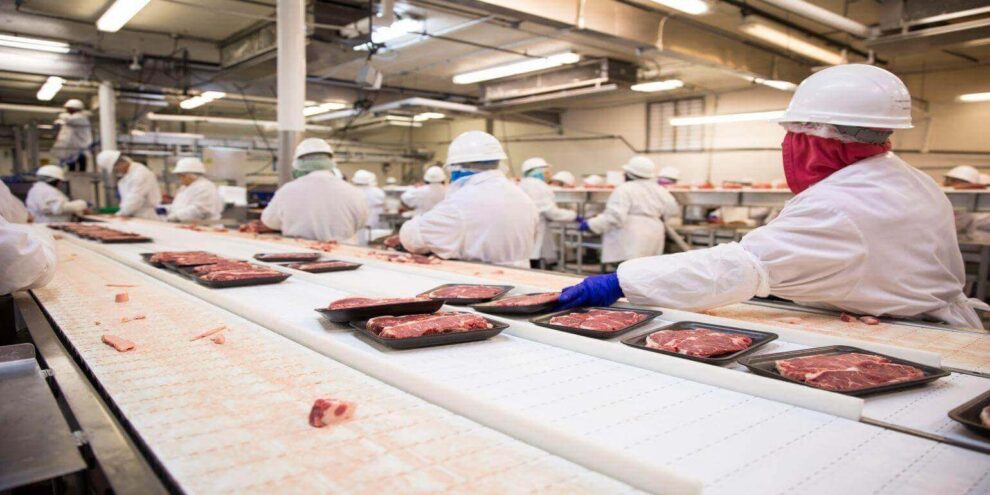Antibiotic-resistant infections are a global concern, especially those caused by multidrug-resistant (MDR) bacteria, defined as those resistant to more than three drug classes. The animal agriculture industry contributes to the antimicrobial resistant foodborne illness burden via contaminated retail meat. In the United States, retail meat is shipped across the country. Therefore, understanding geospatial factors that influence MDR bacterial contamination is vital to protect consumers and inform interventions. Using data available from the United States Food and Drug Administration’s National Antimicrobial Resistance Monitoring System (NARMS), we describe retail meat shipping distances using processor and retailer locations and investigated this distance as a risk factor for MDR bacteria meat contamination using log-binomial regression. Meat samples collected during 2012–2014 totaled 11,243, of which 4791 (42.61%) were contaminated with bacteria and 835 (17.43%) of those bacteria were MDR. All examined geospatial factors were associated with MDR bacteria meat contamination. After adjustment for year and meat type, we found higher prevalence of MDR contamination among meat processed in the south (relative adjusted prevalence ratio [aPR] 1.35; 95% CI 1.06–1.73 when compared to the next-highest region), sold in Maryland (aPR 1.12; 95% CI 0.95–1.32 when compared to the next-highest state), and shipped from 194 to 469 miles (aPR 1.59; 95% CI 1.31–1.94 when compared to meats that traveled < 194 miles). However, sensitivity analyses revealed that New York sold the meat with the highest prevalence of MDR Salmonella contamination (4.84%). In this secondary analysis of NARMS data, both geographic location where products were sold and the shipping distance were associated with microbial contamination on retail meat.
Introduction
Ingestion of pathogenic bacteria contaminated foods have been linked to life-threatening infections, notably from Salmonella and Campylobacter spp.1,2. Salmonellosis and campylobacteriosis cases cause approximately 2.36 million illnesses every year in the United States3,4,5,6. For severe cases which do not self-limit, antibiotics are a mainstay of clinical treatment7,8. However roughly 400,000 (17%) salmonellosis and campylobacteriosis infections are resistant to antibiotics9. Even more concerning is the development of multidrug-resistant (MDR) bacteria, defined as those resistant to more than three antibiotic classes, which limits potential treatment options for infected individuals10.
The animal agriculture industry has been associated with foodborne illness in humans via practices that result in contamination of animal protein food commodities11,12. One of the largest producers and consumers of meat in the world, the United States produced roughly 48 billion kg (110 billion pounds) of red meat and poultry in 201913. This translates roughly to 97 kg (222 pounds) of meat per person annually14. To deliver meat to consumers, the animal agriculture industry ships livestock from producers to processors and processors to retailers, a route known as the farm to fork pathway. This series of steps might result in long distance travel, as far as 20,400 km (12,500 miles) for a single meat product15.
Bacterial pathogens and MDR bacteria have breached all segments of the farm-to-fork pathway. During rearing, animals harbor and are sometimes infected by bacteria16. Despite husbandry practices that restrict antibiotic use in animals, MDR bacteria persist in swine17, beef cattle18, and poultry19. After growing to a market-desired weight, animals are shipped to processor facilities, where they are harvested, packaged, and shipped again for purchase.
Processor facilities hold an intermediary role between farm and fork. During animal harvest, specific steps such as defeathering, evisceration, polishing, and scalding, might contaminate meat products with bacteria associated with the slaughtered animals20,21,22,23,24 or from the processor environment itself25,26,27,28. After products are packaged, retail meat are shipped up to 1800 km (1100 miles) to retail for human consumers15.
Contamination with pathogenic organisms is common among retail meat; as many as 37–91% of meats in the United States could harbor viable pathogenic bacteria29,30,31, while opportunistic-pathogens and indicator bacteria such as Escherichia coli (E. coli) and Enterococcus spp. might contaminate meat and expose consumers to antimicrobial resistance genes32,33,34. Although retail meats can ship ship long distances, few studies have investigated the relationship between distance and presence of measurable bacterial contamination nor its antimicrobial susceptibility profile. Of those that have examined this relationship, one assumed that the relationship between shipment distance and contamination was negligible based on existence of regulations that require shipping containers to maintain ideal meat storage temperatures35. Another observational study indicated that shifts in transport temperature could stimulate growth36.
Retail meat contaminated with MDR bacteria can cause significant illness and spread antimicrobial resistance genes, thus risk factors that might expose consumers and handlers of retail meat to bacterial contamination should be investigated. The purpose of this study was to describe factors related to processor origin, retailer destination, and shipment distance that could result in consumer exposure to MDR bacteria in retail meat and contribute to human illness.
Materials and methods
Data
National Antimicrobial Resistance Monitoring System
We downloaded the publicly available National Antimicrobial Resistance Monitoring System (NARMS) dataset from the U.S. Food and Drug Administration (FDA), released on November 22, 2019, which catalogued meat samples collected during 2005–2017. The FDA portion of the NARMS coalition publicizes antimicrobial susceptibility information for pathogenic and indicator bacteria isolated from retail chicken breasts, ground turkey, ground beef, and pork chops purchased at grocery stores in 19 participating states (as of 2005, although states have been joined and left over time)37. Metadata available in this database included antimicrobial susceptibility results by isolate, sample meat type (i.e. beef, chicken, pork, or turkey), year when meat was purchased, and state where meat was purchased. Beyond the contents of the publicly available dataset, we acquired retail meat establishment numbers (e-numbers) and retailer address of purchase via a Freedom of Information Act (FOIA) request. Only years 2012–2014 contained relevant data to analyze geospatial risk factors that overlapped with the publicly available NARMS dataset.
Meat, poultry, and egg product inspection
The Food Safety and Inspection Service (FSIS) of the United States Department of Agriculture (USDA) curates the Meat, Poultry, and Egg Product Inspection (MPI) Directory, a registry of e-numbers, processor company names, addresses and contact information, date of certification, and products that USDA FSIS certified-processors handle. Because the MPI compiles a list of processors currently certified, FSIS representatives were consulted to obtain the metadata information from processors that had previously received certification any time from 2010 to 2018. Individual retail meat samples with e-number data were queried in the USDA’s MPI dataset to match processor identities with physical addresses. E-numbers with matches from the cross-referenced MPI dataset had corresponding physical addresses, which we linked with the NARMS dataset. Using physical addresses, new variables were synthesized to group processors at the state and region levels. Processors were aggregated into the USDA-Agricultural Research Service (ARS) defined regions: midwest, northeast, south, and west38. Samples without matched physical addresses were excluded from the main analysis.
Geospatial information software
Although NARMS does not collect information regarding the farm location where the animal was reared, NARMS does collect information regarding processor location and final retail store before consumer purchasing. The distance that retail meats were shipped from processor to final retail was simulated using ESRI ArcGIS software under the assumption that refrigerated tractor-semitrailers deliver retail meat (ArcGIS [GIS software]. Version 10.0. Redlands, CA: Environmental Systems Research Institute, Inc., 2010). The function “Connect Origins to Destinations” was employed with the “Trucking Distance” option selected. The Connect Origins to Destination function calculates the shortest route between two locations, while the “Trucking Distance” modification adjusts routes to only include roads where trucks can legally drive39. Models generated trucking distance in miles, which were further divided into quartiles for interpretability.
The Connect Origins to Destinations function was performed in GIS on available e-numbers. Because 19 meat samples (0.17%) were processed outside of the continental United States (e.g., Alaska, Hawaii, Guam) the Trucking Distance models could not be available, and those meat samples were excluded from the analysis. Post hoc, establishment addresses were aggregated by USDA ERS regions to maintain statistical power.
Data missingness
A missing data analysis was performed to identify each variable’s propensity to predict missingness of the models’ matched e-number categorization—coded matched, unmatched, and not available (NA). As a sensitivity analysis, we performed missing imputation by chained equations (see Section “Sensitivity analyses”).
Statistical analysis
Statistical analyses were conducted to investigate MDR bacterial contamination among retail meat collected in the NARMS during years 2012–2014. Descriptive analyses were performed to enumerate meat sampled from specific states and the U.S. region from where it was processed and calculated the proportion of these meat which exhibited a MDR phenotype. We investigated if the proportion of MDR bacteria changed by year sampled, meat type, and distance the retail meat was shipped as well as by meat type and bacteria genera (among contaminated meat samples).
Unadjusted and multivariable log-binomial generalized linear regression models were developed to evaluate if geospatial features were associated with the prevalence of MDR bacterial contamination, with adjustment for meat type and year collected. For state-sampled and region-processed features, the state or region with the largest sample size were designated as the referent. Stata statistical software program was used to perform all statistical analysis (StataCorp. 2019. Stata Statistical Software: Release 16. College Station, TX: StataCorp LLC).
Sensitivity analyses
We performed several sensitivity analyses. First, we investigated MDR prevalence among contaminated meat as opposed to all meat regardless of contamination. This resulted in a dataset with only meat samples from which bacteria were isolated (i.e., contaminated samples); we refer to this as the “resisters.” Contaminated retail meat samples were coded as either contaminated with MDR bacteria or non-MDR bacteria, and unadjusted and multivariable models evaluated risk factors for MDR bacterial contamination among contaminated meat samples. Additional stratified models were constructed to investigate how bacteria genera and meat type might modify associations between risk factors and MDR bacterial contamination.
Retail meat collection and bacteria isolation protocols differ dependent on the NARMS state. All states tested retail meat for Salmonella contamination, however only Georgia, Oregon, Maryland, and Tennessee tested retail meat for all bacteria genera—Campylobacter, E. coli, Enterococcus, and Salmonella. Other states were only required to test poultry samples for Campylobacter contamination40. Therefore, sensitivity analyses were performed to investigate MDR bacterial contamination risk factors among retail meats in (1) the four states which cultured for all four bacteria genera, (2) Salmonella isolates among all meat samples, and (3) Campylobacter isolates among poultry samples.
To account for missing data, we performed a sensitivity analysis to compare results from the primary, complete case analysis, with those estimated with an imputed dataset. Multiple imputation by chained equations was performed using the mice package, version 3.15.0, in R statistical computing program (RStudio Team (2015). RStudio: Integrated Development for R. RStudio, Inc., Boston, MA URL http://www.rstudio.com/). Missing values were regressed from several variables, including bacterial contamination, bacteria MDR status, number of classes of resistance for those bacteria, date of collection, cut of meat, USDA-certified Organic label on meat, USDA-certified meat processor, raised without antibiotic label status, meat type, state collected, region processed, if meat moved across state lines, the longitude and latitude of where the meat was sampled and where the meat was processed, and the distance that the meat traveled between processor and retail store in miles. Five iterations of the multiple imputation were analyzed with pooled results.
Processor to retail maps
A series of maps were developed to depict the shipment of individual retail meat types within the NARMS states during 2012–2014, using the maps package, version 3.4.1, in RStudio. Using locations gathered through MPI queries and the NARMS database, we aggregated processors and retailers to the state level. Individual retail meat collections were stratified based upon their path, from processor to retail, and connected with an arched line. Those pathways were then evaluated for prevalence of MDR bacterial contamination.
Source : Nature
















